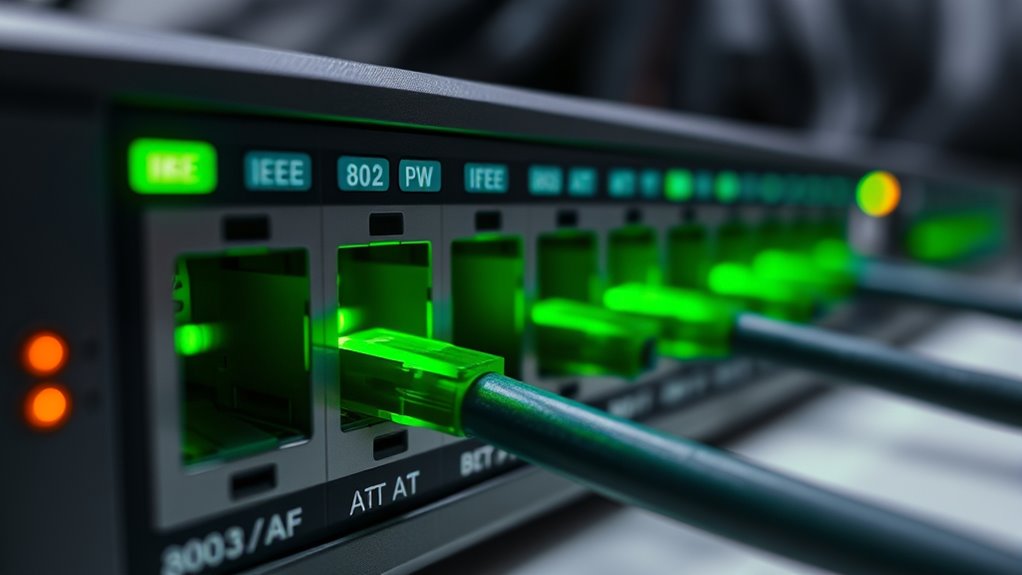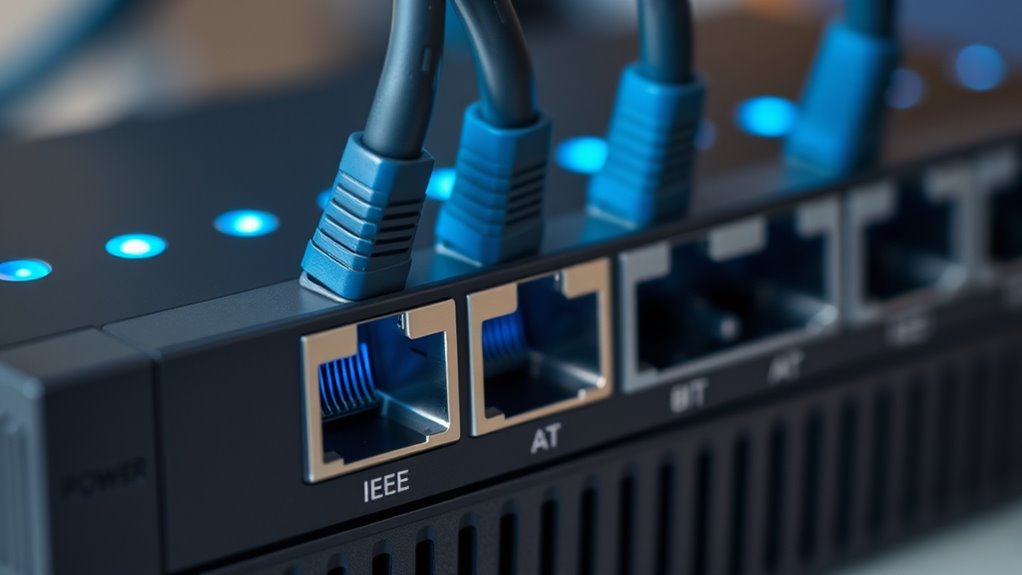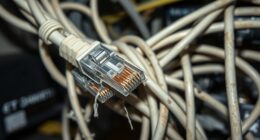Imagine plugging in a device and knowing it’s receiving only the power it needs—no more, no less. That’s what PoE standards like IEEE 802.3af, at, and bt aim to guarantee. These standards ensure your network devices get safe, reliable power, but they differ in capacity and application. Understanding these differences can help you choose the right setup for your needs. So, what exactly sets each standard apart?
Key Takeaways
- IEEE 802.3af, At, and Bt are standards defining power levels and safety protocols for Power over Ethernet (PoE) systems.
- IEEE 802.3af provides up to 15.4W per port, mainly for basic network devices.
- IEEE 802.3at (PoE+) increases power delivery up to 30W, supporting more demanding devices.
- IEEE 802.3bt (PoE++) offers up to 90W per port, enabling high-power applications like cameras and wireless access points.
- Compatibility among these standards ensures safe, efficient, and scalable power delivery over Ethernet networks.

Have you ever wondered what sets Poe apart from other literary standards? While Poe is renowned for his mastery of storytelling, in the sphere of technology, Poe standards focus on delivering reliable power over Ethernet, guaranteeing devices stay operational without the need for separate power supplies. When working with Power over Ethernet (PoE), understanding how power delivery is managed becomes essential. Poe standards like IEEE 802.3af, At, and Bt specify how power is transmitted safely and efficiently across Ethernet cables, which is critical for maintaining device performance and safety. These standards establish clear protocols that guarantee devices receive the right amount of power without risking damage or safety hazards. As you implement PoE setups, knowing these standards helps you select compatible equipment, ensuring seamless operation. Proper adherence to power delivery protocols is vital to prevent issues like overloads or electrical faults, ensuring a stable and safe network environment.
Frequently Asked Questions
How Do Poe Standards Impact Device Compatibility?
You’ll find that PoE standards directly affect device compatibility by setting PoE power limitations, ensuring devices receive the right power levels. When a device has proper PoE device certification, it guarantees safe and reliable operation within these standards. This means if your equipment meets the specific PoE standard, like IEEE 802.3af, At, or Bt, it will work seamlessly with compatible PoE switches and injectors, avoiding potential damage.
Are Poe Standards Backward Compatible With Older Devices?
Yes, PoE standards are generally backward compatible with older devices. When you connect an older device to a newer power source, like an 802.3at or Bt switch, it still receives power, but at the lower, standard level. This guarantees device interoperability and simplifies your setup, so you don’t need separate power sources. Just make sure your power source is compatible with the device’s power requirements for safe operation.
What Safety Features Are Integrated Into Poe Standards?
You benefit from safety features like power management and surge protection in Poe standards. Power management guarantees devices receive the right power levels, preventing overloads or damage, while surge protection shields your equipment from voltage spikes. These features help maintain safe operation, reduce risks of electrical faults, and extend device longevity. By integrating these safety measures, Poe standards promote a reliable, secure power delivery system for your network devices.
Can Poe Standards Supply Power Over Long Distances?
You can’t beat the fact that Power over Ethernet has its limits, especially when it comes to long distances. Usually, Poe standards can supply power effectively up to 100 meters, but beyond that, cable limitations cause voltage drops, reducing power delivery. To extend the range, you might need to use powered network extenders or higher-grade cables to guarantee your devices stay powered without losing signal quality.
How Do Poe Standards Affect Network Security?
PoE standards can enhance your network security by reducing power surges that might damage devices. They also support device isolation, which prevents unauthorized access or data breaches. By using compliant PoE equipment, you guarantee safer power delivery, minimizing risks associated with power fluctuations. Additionally, proper implementation helps protect connected devices from potential cyber threats, making your network more resilient and secure.
Conclusion
Understanding Poe standards is like having the keys to a well-oiled machine—you can choose the right one for your needs and guarantee everything running smoothly. Whether it’s the basic 802.3af, the more powerful 802.3at, or the high-capacity 802.3bt, knowing your options assures you’re not flying blind. By selecting the right standard, you’ll avoid barking up the wrong tree and keep your network humming along seamlessly.









